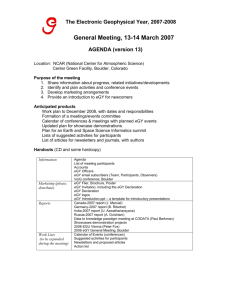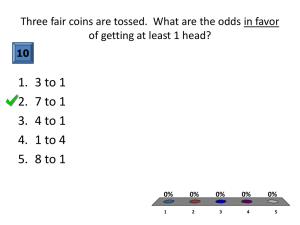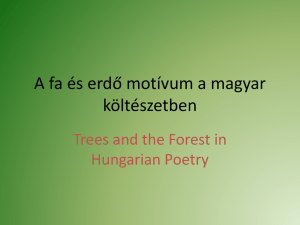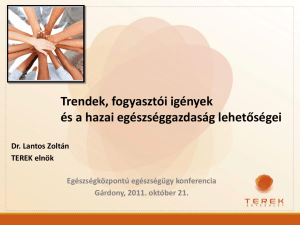Projekt feladat a legendáinkról
advertisement
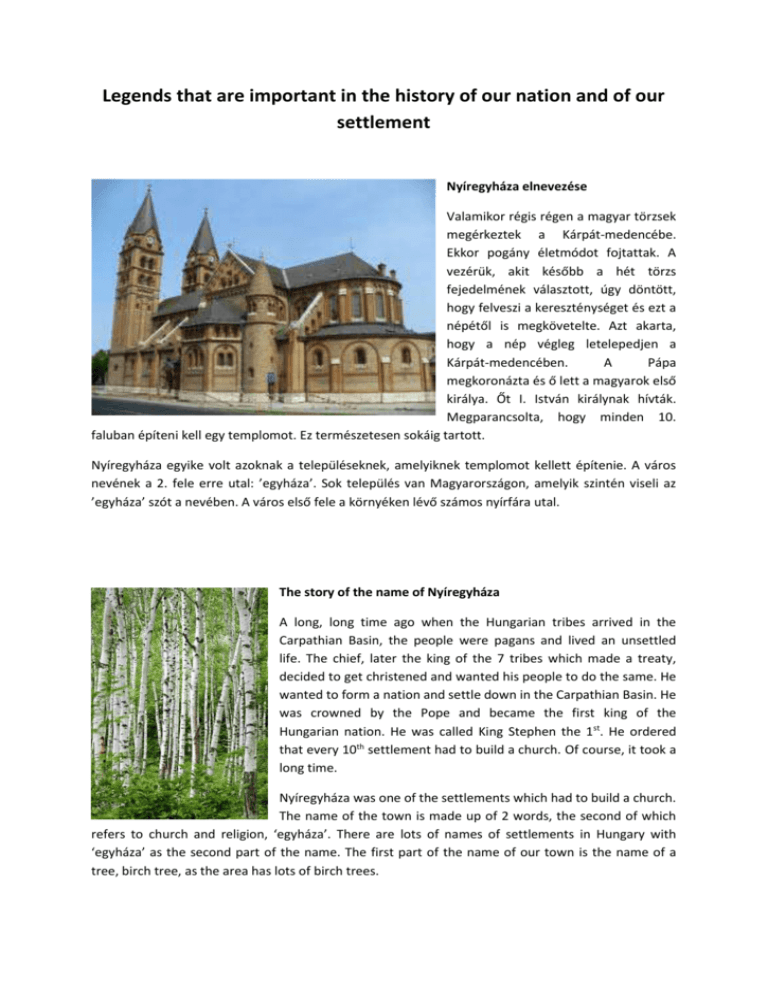
Legends that are important in the history of our nation and of our settlement Nyíregyháza elnevezése Valamikor régis régen a magyar törzsek megérkeztek a Kárpát-medencébe. Ekkor pogány életmódot fojtattak. A vezérük, akit később a hét törzs fejedelmének választott, úgy döntött, hogy felveszi a kereszténységet és ezt a népétől is megkövetelte. Azt akarta, hogy a nép végleg letelepedjen a Kárpát-medencében. A Pápa megkoronázta és ő lett a magyarok első királya. Őt I. István királynak hívták. Megparancsolta, hogy minden 10. faluban építeni kell egy templomot. Ez természetesen sokáig tartott. Nyíregyháza egyike volt azoknak a településeknek, amelyiknek templomot kellett építenie. A város nevének a 2. fele erre utal: ’egyháza’. Sok település van Magyarországon, amelyik szintén viseli az ’egyháza’ szót a nevében. A város első fele a környéken lévő számos nyírfára utal. The story of the name of Nyíregyháza A long, long time ago when the Hungarian tribes arrived in the Carpathian Basin, the people were pagans and lived an unsettled life. The chief, later the king of the 7 tribes which made a treaty, decided to get christened and wanted his people to do the same. He wanted to form a nation and settle down in the Carpathian Basin. He was crowned by the Pope and became the first king of the Hungarian nation. He was called King Stephen the 1st. He ordered that every 10th settlement had to build a church. Of course, it took a long time. Nyíregyháza was one of the settlements which had to build a church. The name of the town is made up of 2 words, the second of which refers to church and religion, ‘egyháza’. There are lots of names of settlements in Hungary with ‘egyháza’ as the second part of the name. The first part of the name of our town is the name of a tree, birch tree, as the area has lots of birch trees. A Sóstói erdő legendája Sóstó, amelyik Nyíregyházához közel eső üdülő és pihenőközpont, egy nagy erdővel rendelkezik. A helyiek büszkék rá és szívesen tesznek nagy sétákat, bicikliznek, vagy piknikeznek benne. A 19. század végéről visszamaradt anekdota szerint a mai erdő területe egy földbirtokosé volt, aki ideje nagy részét külföldön töltötte. Távolléte alatt egy táviratot küldött, amelyben azt parancsolta a földjét művelőknek, hogy ültessenek mákot a földjén, mert a mák ára magasra szökött. De a táviratban nincs ékezet, így a mákot, makknak olvasták, s mire a földesúr hazaért, már egy szép kis tölgyfaerdőt talált a földjén. The legend of the forest in Sóstó Sóstó, which is a recreation centre and holiday resort close to Nyíregyháza, has a huge forest. Local people are proud of it and love taking long walks, going jogging, cycling, or having a picnic there. There is a kind story of the origin of the forest from the 19th century. The territory of the forest belonged to a landowner who spent most of his time abroad. While he was away he sent a telegram back home, in which he ordered his peasants to plant poppy as the price of the poppy was high at that time. But in the Hungarian language poppy is mák and acorn is makk. The two words are very similar. Due to the wrong spelling of the landowner, oak trees were planted instead of poppy seeds. So by the time the landowner returned to his land, he found a young oak forest on his land. A fehér ló mondája Amikor a magyarok megérkeztek a Kárpát-medencébe, nem telepedtek le azonnal. Először meg akarták ismerni a földet. A vezérük kiválasztott egy erős embert, hogy lovagolja be a területet, hogy megismerje, kik lakják és milyen ott a föld. Ezt a férfit Kusidnak hívtak. Kusid végiglovagolt a területen. Megérkezett egy városba, ahol Szvatopluk nevű fejedelem volt a nép vezére. Kusin elmondta neki, hogy a magyarok le akarnak telepedni ezen a földön. Szvatopluk örült, mert arra számított, hogy a magyarok szorgalmasan művelik majd a földjét. Kusin nem mondott semmit. Visszafelé menet vett magához egy kis földet és a Duna folyó vizéből megtöltötte a kulacsát, és vitte a magyarok vezérének. Árpád vezér azzal bízta meg Kusint, hogy adjon Szvatopluknak egy gyönyörű fehér lovat a földért és a vízért cserébe. Kusin elvitte a lovat Szvatopluknak, akinek tetszett az ajándék, és azt mondta, hogy a magyarok vehetnek annyi földet és annyi vizet, amennyit akarnak. Így Árpád vezér elindult az embereivel, hogy megkapja, amit Szvatopluk ígért. Természetesen Szvatopluk meglepődött és harcba szállt a magyarok ellen. A magyarok legyőzték őt. Ez a fehér ló legendája, és ezért mondjuk, hogy a magyarok a földjüket egy ló áráért vették. The legend of the white horse When the Hungarians arrived in the Carpathian Basin they didn’t settle down straight away. They wanted to learn about the land first. The chief chose a strong man from the army to ride his horse around the basin to see who lived here, what the land was like. The name of the strong man was Kusid, who rode his horse all over. He arrived at a town where Szvatopluk was the head of the people. Kusin told him that the Hungarians want to settle down on the land. Szvatopluk said that he was happy as long as the Hungarians are hardworking people and work the land for him. Kusin said nothing. On the way back to the Hungarian chief he took some land and water of the river to prove the chief how good the land and the water are there. Árpád, the chief told Kusin to give Szvatopluk a beautiful white horse in return for the land. Kusin took the horse and gave it to Szvatopluk, who liked the present very much and said that the Hungarians could take as much land and water as they wished. So Árpád and the tribes set off to get the land Szvatopluk promised them. Of course, Szvatopluk was surprised and fought against Árpád, but the Hungarians finally defeated him. This is the legend of the white horse and that is why the Hungarians say that they bought their land for the price of a horse.



